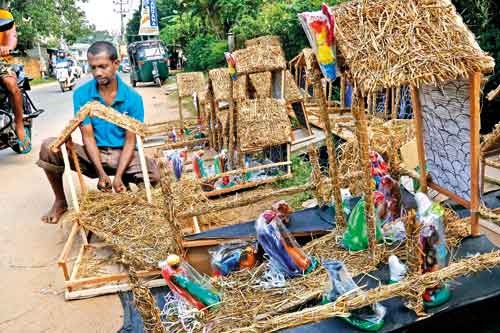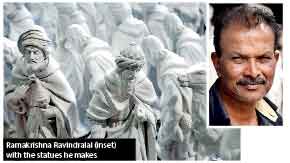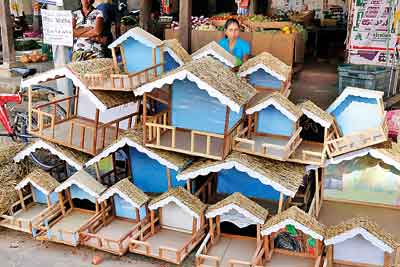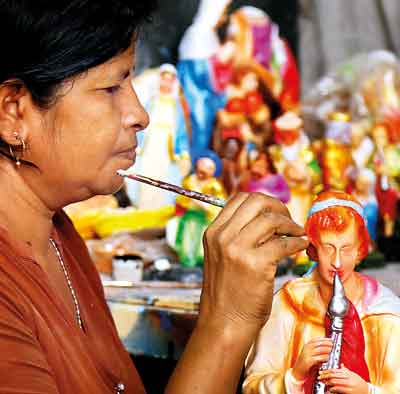Mangers made with love

All hand-made: Jude Ajith Peris with his mangers at Kochchikade. Pix by M.A. Pushpa Kumara
While many are out celebrating the Christmas season, he has been working till 10 or 11 every night, adding finishing touches to the face of a statue of baby Jesus or one of the Wise Men, ensuring that every feature is painted perfectly so that the figures in each nativity set he makes instil a sense of wonder in believers. “I’m Catholic and I don’t want to make figures of Jesus in a careless manner,” says Ramakrishna Ravindralal, who has been making nativity figures for the past 29 years.
In this day and age when the Christmas season is a time of celebration, when big advertisements of the latest goods and lavish parties are the norm, there are many who feel that the essence of Christmas has been lost. Perhaps the Christmas nativity scene is a better symbol of Christmas than the glittering city lights, as it reminds us of the significance of Christmas – the birth of Jesus in a humble manger, accessible to all and saviour of all mankind.
 Christmas nativity scenes date back to 1223 AD, when Saint Francis of Assisi created the first known nativity scene in the Italian city of Greccio. He transformed a cave into a hay-filled manger with people re-enacting the scene of the first Christmas along with a few farm animals. In the decades following, many people started enacting the Christmas story, until it was eventually replaced by the wooden manger and nativity figures, we know today. The purpose of the nativity scene, however, remains unchanged. Saint Francis of Assisi envisioned that it would help people move away from the materialism they engaged in and achieve a sense of spirituality, a belief held by Christians even to this day. The mangers made commonly in the area of Negombo even today are not elaborate, but simple structures designed to recreate the scene of that first Christmas in a stable in Bethlehem.
Christmas nativity scenes date back to 1223 AD, when Saint Francis of Assisi created the first known nativity scene in the Italian city of Greccio. He transformed a cave into a hay-filled manger with people re-enacting the scene of the first Christmas along with a few farm animals. In the decades following, many people started enacting the Christmas story, until it was eventually replaced by the wooden manger and nativity figures, we know today. The purpose of the nativity scene, however, remains unchanged. Saint Francis of Assisi envisioned that it would help people move away from the materialism they engaged in and achieve a sense of spirituality, a belief held by Christians even to this day. The mangers made commonly in the area of Negombo even today are not elaborate, but simple structures designed to recreate the scene of that first Christmas in a stable in Bethlehem.

Fr. Manjula Niroshan
Explaining the significance of the crib, Fr. Manjula Niroshan of St. Francis de Sales Church, in Kattuwa, Negombo said the crib should represent the original manger in Bethlehem. “The Christmas crib should not be an elaborate structure with decorations. The manger was a lowly place, unclean because of the animals. It becomes a clean and holy place after the birth of Jesus Christ and today it signifies that our hearts become holy and spiritual only when we start to believe in Jesus,” he explains.
The crib welcomes both the poor and the rich, as portrayed by the kings and the shepherds in the scene. “The idea of the Holy Family generates from the crib. It is the whole essence of Christmas in which every family should attempt to become a holy family by creating a peaceful household,” he adds.
Making the crib at home with whatever is available is better than buying a crib, he says.
Christmas is being commercialized today as people have forgotten the true meaning of what they celebrate, spending money unnecessarily, he feels. Giving to the poor, letting go of old enmities and being peaceful and spiritual, while spending time with family in unity is the best way to celebrate Christmas.

Sumithra Fonseka
In Kochchikade we meet Jude Ajith Peris who spends the two weeks before Christmas making and selling the wooden cribs. A devout Catholic, he recalls a time when he desperately tried to fix two wooden bars together to make his very first crib 14 years ago – a failed attempt. His second attempt was more successful and he made a simple manger. Today he has mastered his craft, making a sloped bridge which depicts the journey of the three Wise Men, who travelled over mountains and fields to visit Jesus bringing their gifts of gold, frankincense and myrrh. His cribs range in price from Rs. 100 to 18,000 (for a manger with a complete set of figures).
Jude uses the money he earns from selling cribs to buy school supplies for his children. “My son helps me make cribs and now he can make a complete Christmas crib on his own,” he says with pride, referring to his 15-year-old son Sisira Thenuka Peris. Jude perceives the whole idea of Christmas to be a holy and spiritual event where everyone should be kind to each other.

Thilini Surasena with her Christmas cribs
Sumithra Fonseka took on the practice of selling homemade Christmas cribs from her father seven years ago. Sumithra’s husband helps her make the wooden structure of the crib which she completes by adding straw and pasting the drawings done by her grandchildren in the background. Because her husband is a day labourer, they start making cribs in October after he finishes work and during weekends. Selling the cribs at her house in Soysapura, Kochchikade, she uses the money she earns to buy presents for her grandchildren. Her cribs range in price from Rs. 200 – 400, while she makes bigger cribs to order.
For Sumithra, Christmas is all about family. “Each year I prepare a Christmas lunch for my children and the grandchildren. Some of my grandchildren are participating in our village Christmas play as well. That is how we celebrate Christmas,” says Sumithra, smiling brightly.
Selling Christmas cribs on behalf of her husband is Thilini Randima Surasena whose Catholic husband has been making cribs for the past four years – Thilini herself is Buddhist. Her husband Dilum is a mason by profession, who labours at the task of making cribs for four months after work ends or at night.

Lakshmi carefully paints a statue
Ravindralal’s labour of love began 29 years ago when he learnt how to make statues from an Indian who was visiting Sri Lanka. A statue takes a minimum 10 laborious days to finish, with the mixture of water and plaster of paris added to a mould taking days to dry before the shape of the statue is perfected and then painted. He makes nativity figures in December and spends the rest of the year making statues of Jesus and the Saints. Although he has a staff of about 10, he does not let anyone add the finishing touches to the statues. “I want to create a sense of wonder in the devotee,” he explains.
He is averse to selling his statues to shops because he dislikes working with profit-oriented salespeople, preferring to make statues for the priests directly. His wife Lakshmi Rohini Silva and sons Shashi Wijendra and Sajith Surendra take an active role in making the statues, with his wife diligently painting the moulded statues.
The crib and nativity figures are a labour of love from their hands to your home – and their hope that their honest day’s work will be rewarded by God. They have no use for expensive gifts and elaborate festivities, spending the money they earn on school supplies and other necessities. For them, Christmas is about love and family, peace and generosity. Perhaps their hard work and faith is an example for all who celebrate Christmas.


